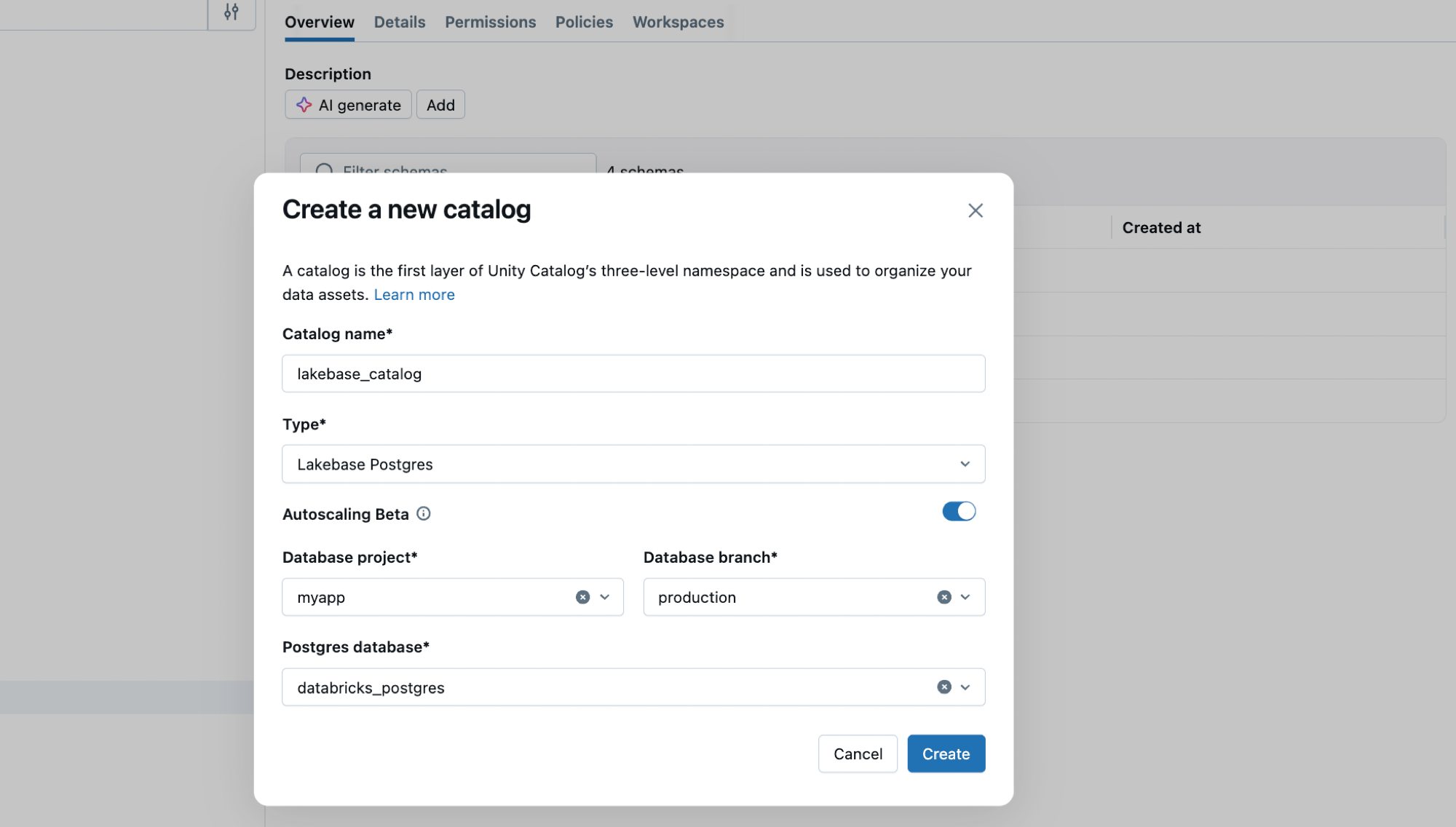Register a Lakebase database in Unity Catalog
Lakebase Postgres (Autoscaling Beta) is available in the following regions: us-east-1, us-west-2, eu-west-1.
This Beta release is the next version of Lakebase, available for evaluation only. For production workloads, use Lakebase Public Preview. See choosing between versions to understand which version is right for you.
Registering a Lakebase database in Unity Catalog creates a read-only catalog that represents your Postgres database, enabling unified data governance and cross-source analytics across your lakehouse and transactional workloads.
Why register in Unity Catalog
Registration provides several benefits:
Unified governance: Apply Unity Catalog's governance controls—permissions, lineage tracking, and audit logs—to your Lakebase data alongside your lakehouse data.
Cross-source queries: Query both Unity Catalog tables and Lakebase databases from a single SQL interface, enabling analytics that combine transactional and analytical data.
Centralized discovery: Browse and discover Lakebase databases, schemas, and tables through Catalog Explorer alongside other data sources in your workspace.
Integrated workflows: Use Lakebase data in Databricks dashboards and applications without switching contexts or managing separate connections.
How it works
Registration creates a read-only Unity Catalog catalog that mirrors your Postgres database structure, providing metadata access to your database objects (schemas, tables, views) through Unity Catalog's governance layer.
You initiate registration from Catalog Explorer rather than from the Lakebase interface, which integrates naturally with Unity Catalog's catalog creation workflow.
After registration:
- Your Lakebase database appears as a catalog in Unity Catalog
- Unity Catalog permissions control who can view and query the database
- The catalog remains read-only—you manage the actual database through Lakebase
Prerequisites
- An existing Lakebase project with at least one database
CREATE CATALOGprivileges on the Unity Catalog metastore- A serverless SQL warehouse to query the registered catalog
Register a database
To register a Lakebase database in Unity Catalog:
- Use the apps switcher to navigate to Lakehouse.
- In Catalog Explorer, click the plus icon and Create a catalog.
- Enter a catalog name (for example,
lakebase_catalog). - Select Lakebase Postgres as the catalog type and enable the Autoscaling Beta option.
- Select your project, branch, and Postgres database.
- Click Create.

The catalog appears in Catalog Explorer, where you can browse schemas, tables, and views, and query them using SQL warehouses.
Explore registered databases
After registration, navigate to your catalog in Catalog Explorer to browse schemas, tables, and views. Click any table to view schema details, sample data, and lineage information.
Unity Catalog automatically syncs metadata from your Lakebase database. When you add or modify tables in Lakebase, refresh the catalog view to see updates.
Query registered databases
Query registered Lakebase databases using SQL warehouses or any tool that connects to Unity Catalog:
-- Query a registered :re[LKB] database
SELECT * FROM chatbot_catalog.public.conversations
WHERE created_at >= current_date - INTERVAL 7 DAYS;
-- Join :re[LKB] and lakehouse data
SELECT
c.conversation_id,
c.user_id,
c.agent_response,
u.user_name,
u.subscription_tier
FROM chatbot_catalog.public.conversations c
JOIN main.user_analytics.users u
ON c.user_id = u.user_id;
The read-only catalog ensures queries don't modify your Lakebase database through Unity Catalog. To modify data, use the Lakebase SQL Editor or connect directly to your database.
Permissions and access control
Unity Catalog permissions control access to registered Lakebase databases:
- Catalog ownership: The user who registers the database becomes the catalog owner
- Read access: Grant
USE CATALOGandSELECTprivileges to allow others to query the database - Metastore admin: Metastore admins can manage all registered catalogs
To grant access to a registered database:
-- Grant read access to a group
GRANT USE CATALOG ON CATALOG chatbot_catalog TO `ai-engineering`;
GRANT SELECT ON CATALOG chatbot_catalog TO `ai-engineering`;
Permissions set in Unity Catalog control query access through SQL warehouses. Direct connections to your Lakebase database use Postgres roles and permissions independently.
Unregister a database
To unregister a Lakebase database from Unity Catalog, select the catalog in Catalog Explorer, click the , and select Delete.
Deleting the catalog removes it from Unity Catalog but doesn't affect your Lakebase database. The database remains accessible through Lakebase and direct Postgres connections.
If you created synced tables from the registered database, delete those tables first. Each source table can only be used to create 20 synced tables, and synced tables pending deletion count toward this limit.
Limitations
Read-only access: Catalogs registered from Lakebase databases are read-only. You can't modify data through Unity Catalog queries.
Single database per catalog: Each Unity Catalog catalog represents one Lakebase database. To expose multiple databases, register each one separately.
Metadata sync: Unity Catalog caches metadata to reduce Postgres requests. New objects may not appear immediately. Click to trigger a full refresh.
Branch isolation: Catalogs register databases from specific branches. To access data from multiple branches, register a database from each branch as a separate catalog.
Next steps
- Manage databases to learn how to create and manage Lakebase databases
- Database branches to understand how branches organize your data
- Query with the SQL Editor to query your Lakebase databases directly